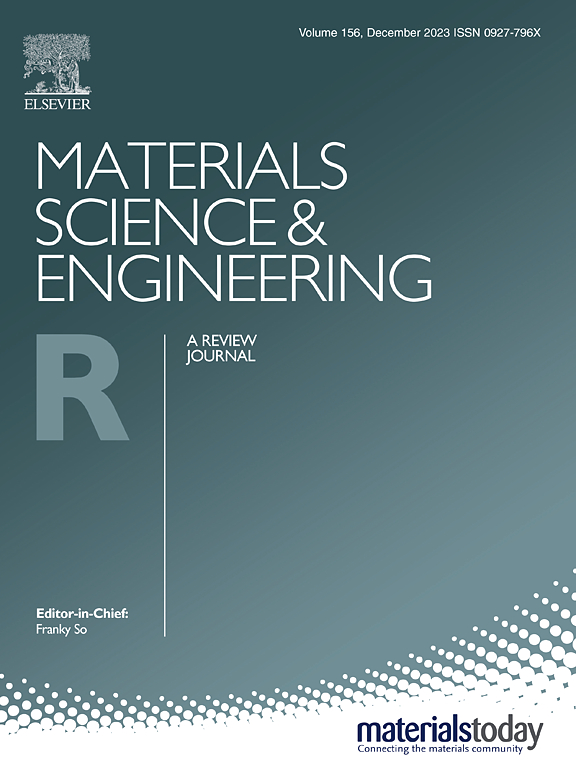Water‐Induced Modulation of Bipolaron Formation in N-type Polymeric Mixed Conductors
IF 31.6
1区 材料科学
Q1 MATERIALS SCIENCE, MULTIDISCIPLINARY
引用次数: 0
Abstract
N-type organic mixed ion-electron conductors (OMIECs) are a unique class of organic materials, capable of both transporting and coupling cations and electrons. While important for various devices operating in an aqueous electrolyte, understanding n-type mixed conduction remains challenging due to a lack of comprehensive data, which impedes the rational design of high performance electronic materials. Using a diverse array of in situ spectroscopy techniques, including an electrochemical spectro-gravimetric tool, Raman spectroscopy, and grazing-incidence wide angle X-Ray scattering, we investigate the electrochemical doping of two polymeric n-type OMIECs with differing oligoether side chain length. We find that the polymer films swell drastically during electrochemical reduction, with electrolyte uptake scaling proportionally to the length of the polar side chains, ultimately disrupting the crystalline structure. Electrolyte ingress in the film has two important consequences. First, the extent of water uptake during reduction governs the nature of polaronic species formed at the same doping voltage, which we studied by varying aqueous salt concentration and using ionic liquid electrolytes. Second, swelling regulates oxygen reduction reaction rates, revealing the importance of side-chain chemistry in controlling the electrochemical side reactions of the OMIECs. This study underscores the critical role of water, traditionally perceived as a passive element, in influencing the optoelectronic and electrochemical properties of OMIEC films and suggests in situ electrolyte permeation as a crucial material specification when designing n-type devices for electrochromic displays, energy storage, and catalysis.
n型聚合物混合导体中双极化子形成的水诱导调制
n型有机混合离子电子导体(OMIECs)是一类独特的有机材料,能够传输和耦合阳离子和电子。虽然对于在水电解质中工作的各种器件很重要,但由于缺乏全面的数据,理解n型混合导电仍然具有挑战性,这阻碍了高性能电子材料的合理设计。使用多种原位光谱技术,包括电化学光谱-重量测量工具、拉曼光谱和掠射广角x射线散射,我们研究了两种具有不同寡聚醚侧链长度的聚合物n型omiec的电化学掺杂。我们发现聚合物薄膜在电化学还原过程中急剧膨胀,电解质吸收与极性侧链的长度成比例,最终破坏了晶体结构。电解质进入薄膜有两个重要的后果。首先,还原过程中的吸水程度决定了在相同掺杂电压下形成的极性物质的性质,我们通过改变含水盐浓度和使用离子液体电解质来研究。其次,溶胀调节氧还原反应速率,揭示了侧链化学在控制omiec电化学副反应中的重要性。这项研究强调了水在影响OMIEC薄膜光电和电化学性能方面的关键作用,传统上认为水是一种被动元素,并建议在设计用于电致变色显示、储能和催化的n型器件时,原位电解质渗透是关键的材料规格。
本文章由计算机程序翻译,如有差异,请以英文原文为准。
求助全文
约1分钟内获得全文
求助全文
来源期刊

Materials Science and Engineering: R: Reports
工程技术-材料科学:综合
CiteScore
60.50
自引率
0.30%
发文量
19
审稿时长
34 days
期刊介绍:
Materials Science & Engineering R: Reports is a journal that covers a wide range of topics in the field of materials science and engineering. It publishes both experimental and theoretical research papers, providing background information and critical assessments on various topics. The journal aims to publish high-quality and novel research papers and reviews.
The subject areas covered by the journal include Materials Science (General), Electronic Materials, Optical Materials, and Magnetic Materials. In addition to regular issues, the journal also publishes special issues on key themes in the field of materials science, including Energy Materials, Materials for Health, Materials Discovery, Innovation for High Value Manufacturing, and Sustainable Materials development.
 求助内容:
求助内容: 应助结果提醒方式:
应助结果提醒方式:


